Trees of the Adirondacks:
Black Spruce (Picea mariana)
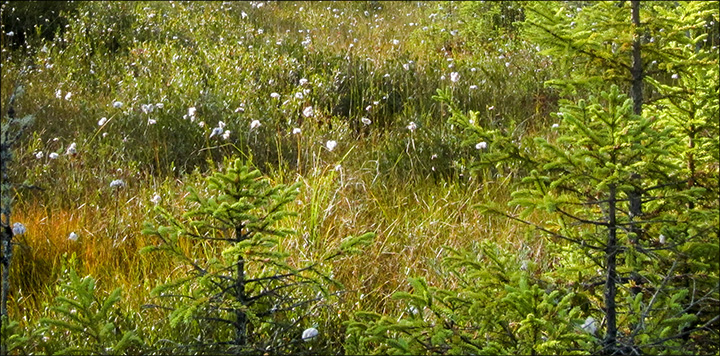 Trees of the Adirondacks: Black Spruce growing in a sea of Cotton Grass on Barnum Bog at the Paul Smiths VIC (22 September 2012)
Trees of the Adirondacks: Black Spruce growing in a sea of Cotton Grass on Barnum Bog at the Paul Smiths VIC (22 September 2012)
| This page is no longer being updated. For an updated and expanded version of this material, see: Black Spruce (Picea mariana). |
Black Spruce (Picea mariana) is a slow-growing evergreen conifer which grows in the Adirondack Mountains, especially in bogs. It is also referred to as Bog Spruce, Swamp Spruce, and Shortleaf Black Spruce. Black Spruce is the provincial tree of Newfoundland. It is a member of the pine family. The Black Spruce reportedly derives its common name from the dark hue of its foliage in certain habitats; when massed on mountain slopes in the northern portions of its range, it appears to be black rather than green. However, in the Adirondacks, Black Spruce grow more commonly in bogs and do not appear noticeably dark.
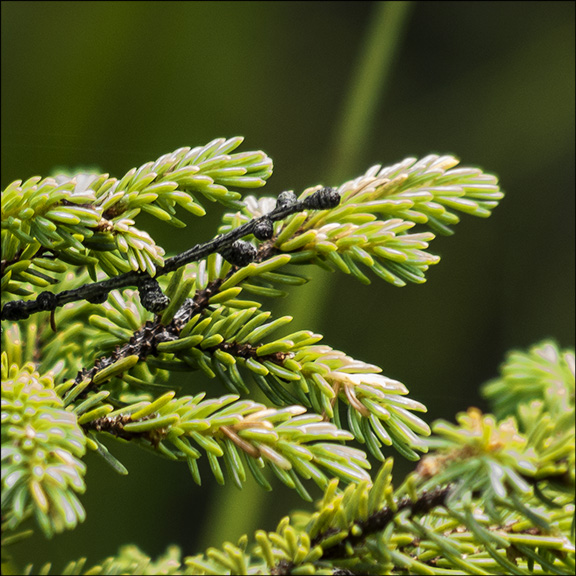
Identification of the Black Spruce: Keys to identifying the Black Spruce include its needles, cones, growth habit, and habitat.
- Like Red Spruce and Balsam Fir, Black Spruce needles are short – about half an inch long – in contrast to the Eastern White Pine, whose needles are generally three to five inches long.
- The needles of the Black Spruce are attached individually to the branches, rather than in clusters.
- In contrast to Balsam Fir and Eastern Hemlock, whose needles appear to occupy a single horizontal plane, the Black Spruce has needles around the entire radius of the branch. Black Spruce needles, like the needles of other spruce trees, are also very hard, making it easy to poke or stick yourself with them.
- Like the needles of other spruce trees, Black Spruce needles needles have four sides, rather than two, which means that the needles of the Black Spruce are easy to roll back and forth between your fingers. By contrast, Balsam Fir needles are flat.
- Black Spruce needles, like those of other spruce trees, are attached to small, stalk-like woody projections. When its needles are shed, these projections remain, and the branches feel rough to the touch.
- In the Adirondacks, the most reliable means to identify Black Spruce is habitat. Black Spruce occupies the wettest sites, such as boreal bogs, and co-mingles with Tamaracks. Red Spruce is less tolerant of boggy soil and is usually mixed with Balsam Fir. White Spruce is also more commonly found on upland sites. If the tree is a spruce and you observe it in a bog, it's almost certainly a Black Spruce.
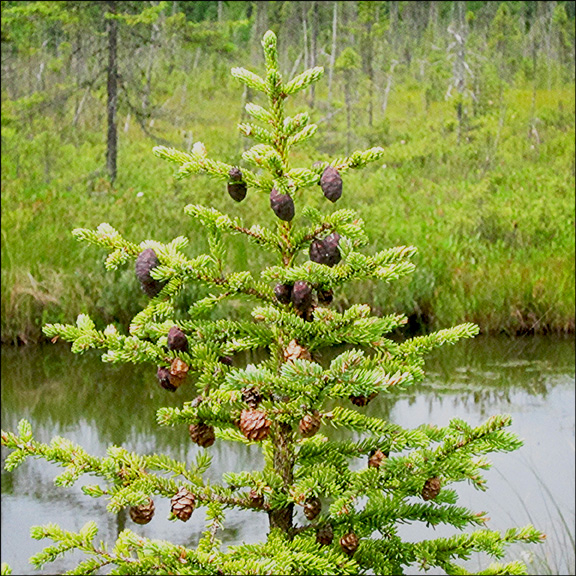
Black Spruce cones are the smallest of all of the spruces. They are egg-shaped to nearly round, usually about .5 to 1.5 inches long. They are dark purple, ripening to red-brown. The cones are produced in dense clusters in the upper crown, opening at maturity but persisting for many years. Black Spruce trees usually start bearing cones when they are thirty years old, although a few cones may be produced after ten years. Black Spruce cones remain partially closed and disperse seed for several years, providing an adequate supply of seeds to reproduce the stand whenever fire occurs. The bark of the Black Spruce is thin, scaly and dark greenish-brown.
Black Spruce trees, in contrast to other spruces, grow tall and narrowly, as opposed to conically. Black Spruce are slow growers, with a shallow root system making the tree susceptible to wind throw. Growth is quite variable depending upon site conditions. Throughout much of its range, trees average 30 to 50 feet in height and 6 to 10 inches in diameter at maturity. However, in wetland areas in the southern parts of its range, including the Adirondack Mountains, especially on bog sites of low fertility, Black Spruce can remain stunted for decades. Trees on the borders of a wetland area tend to be taller, while those in the center may be only five or ten feet tall.
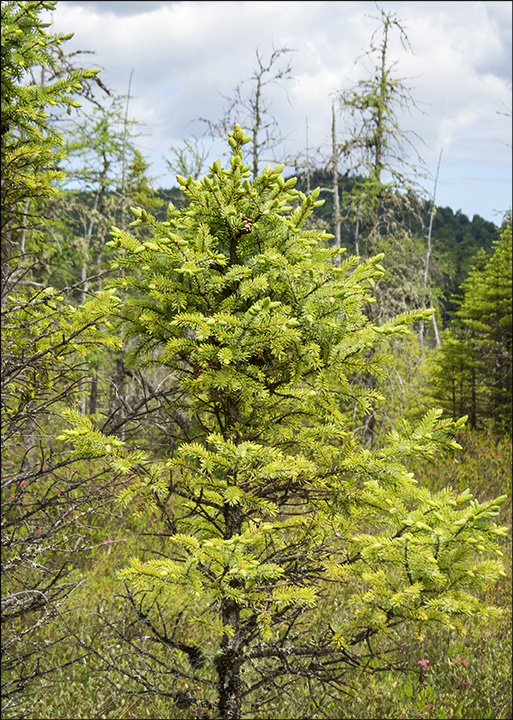
Uses of the Black Spruce: The primary use of Black Spruce wood is for pulp. Lumber is of secondary importance, because of the relatively small size of the trees. The trees and wood also are used for fuel and Christmas trees. Native American tribes used the roots to sew baskets and snowshoes. The wood was also used to make canoe paddles and the pitch to seal seams on birch bark canoes.
Black Spruce has a number of edible uses. For instance, the young male catkins reportedly can be used as a flavoring. The central portion of immature female cones, when roasted, is sweet and syrupy. The inner bark is usually harvested in the spring and can be dried, ground into a powder, and then used as a thickener in soups. The seeds can be eaten raw, as an emergency food. A refreshing tea, rich in vitamin C, reportedly can be made from the young shoot tips . A tea is also made from the needles and the bark.
Black Spruce is also a source of spruce gum and spruce beer. In the 19th century, gum pickers on snowshoes gathered resin from Black Spruce using poles fitted with chisels to knock off the resin. Spruce gum should be aged for 3 days or more before using it. The best gum is said to be obtained from the southern side of the tree. Spruce beer, which apparently can be made from both Black Spruce and Red Spruce, is made by boiling the young twigs with molasses and sugar; the mixture is then fermented to produce spruce beer. The beer is ready to drink in a week and is considered to be a good source of minerals and vitamins.
Black Spruce reportedly was employed medicinally by many native American tribes for a wide variety of ailments. For example, the Algonquin use the gum of the Black Spruce as a salve. The Cree mixed the pitch of the Black Spruce with grease and used it as an ointment for burns and skin rashes; they also used a decoction of cones as a gargle for sore throats and chewed the cone for toothaches. Eskimos are said to have used a decoction of Black Spruce gum or needles as a treatment for respiratory infections. The Ojibwa used an infusion of roots and barks for stomach pain and fits. A poultice of the inner bark was used as a disinfectant by the Potawatomi to treat inflammations.
Wildlife Value of the Black Spruce: The Black Spruce is a food source for several wildlife species. Snowshoe hares browse on Black Spruce seedlings and may cause extensive damage to seedlings and saplings when populations of hare are high. Red squirrels gather cones in large quantities and give a peculiar clumped appearance to the top of the tree. This plant is a larval host for the Bog Elfin butterfly.
A number of boreal birds breed in habitats associated with Black Spruce. These include:
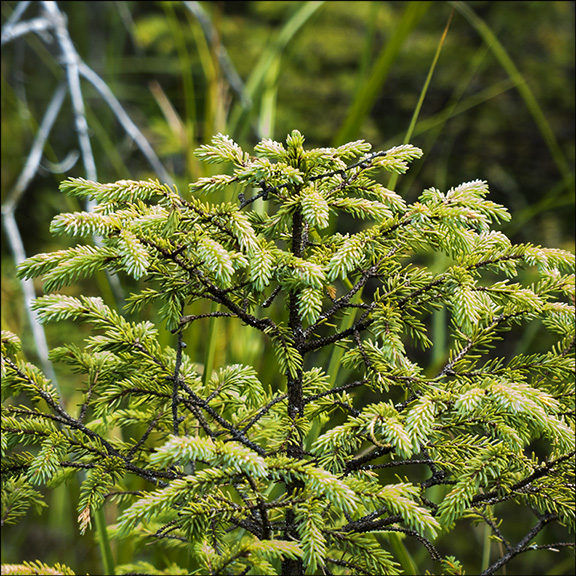
Distribution of the Black Spruce: Black Spruce is essentially a Canadian species, in that the bulk of its North American range is in Canada. In the US, the Black Spruce's range includes Maine, upstate New York (including the Adirondacks and the Catskills), plus the northern portions of Minnesota and Wisconsin and parts of Alaska.
Black Spruce grows on both lowland and upland sites. In the southern parts of its range (including the Adirondack Mountains), Black Spruce is most abundant in wet habitats, such as peat bogs and swamps, but it may also be found on transitional sites between peat lands and uplands. In Alaska, Black Spruce occupies poorly-drained areas, such as cold wet flats, muskegs, bogs, and north-facing slopes.
The Black Spruce is one of the indicator plants of the Boreal Bog, where it is commonly found with Tamaracks. Shrubs associated with Black Spruce include Bog Rosemary, Labrador Tea, Leatherleaf, and Bog Laurel.
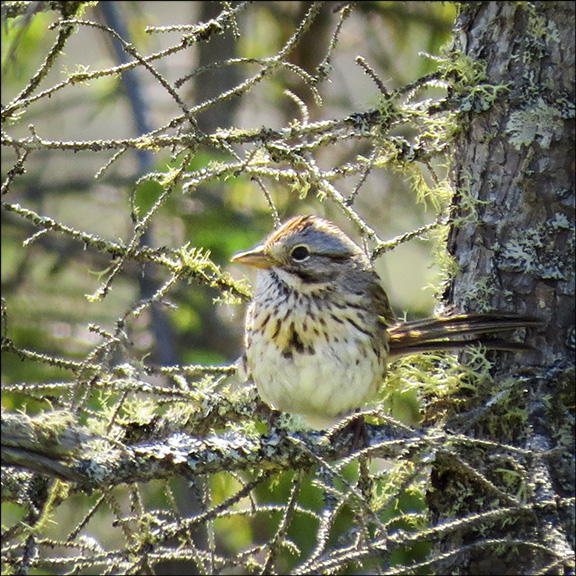
Black Spruce at the Paul Smiths VIC: The best place to observe Black Spruce at the Paul Smiths VIC is the Boreal Life Trail. This trail features a 1,600-foot boardwalk across Barnum Bog. Only two trees grow on the bog: Black Spruce and Tamarack.
These two tree species co-exist with a host of bog-dwelling plants. Shrubs, such as Sheep Laurel, Bog Laurel, Leatherleaf, Bog Rosemary, and Labrador Tea, thrive on the thick carpet of sphagnum moss that covers Barnum Bog. Wildflowers, such as Roundleaf Sundew, Pitcher Plant, Buckbean, Cotton Grass, and Marsh Cinquefoil share the acidic habitat with Black Spruce. Barnum Bog also hosts a variety of orchids that thrive in wet soil, such as Grass Pink, Rose Pogonia, and White-fringed Orchids.
Several species of birds are often seen perching on or near the Black Spruce on Barnum Bog, including Yellow-bellied Flycatchers, Cedar Waxwings, and Yellow-rumped Warblers. Palm Warblers and Lincoln's Sparrows are known to nest on Barnum Bog and are often seen and heard here.
References
- United States Department of Agriculture. Forest Service. Silvics of North America. Black Spruce. Retrieved 13 January 2015.
- United States Department of Agriculture. Plants Database. Retrieved 14 January 2015.
- Lady Bird Johnson Wildflower Center. Native Plant Database. Retrieved 14 January 2015.
- University of Wisconsin. Trees of Wisconsin. Picea mariana. Retrieved 14 January 2015.
- Flora of North America. Plant Database. Retrieved 14 January 2015.
- Online Encyclopedia of Life. Picea mariana. Retrieved 14 January 2015.
- University of Wisconsin. Robert W. Freckmann Herbarium. Retrieved 14 January 2015.
- New York Flora Association. New York Flora Atlas. Retrieved 14 January 2015.
- University of Michigan. Native American Ethnobotany. A Database of Foods, Drugs, Dyes and Fibers of Native American Peoples, Derived from Plants. Retrieved 14 January 2015.
- Plants for a Future. Database. Retrieved 14 January 2015.
- The Birds of North America. Ruby-crowned Kinglet; Palm Warbler; Lincoln's Sparrow; Black-backed Woodpecker; Nashville Warbler; Gray Jay; Pine Grossbeak; Yellow-rumped Warbler; Cape May Warbler; Mourning Warbler; Spruce Grouse; Yellow-bellied Flycatcher; White-throated Sparrow; Bay-breasted Warbler; White-winged Crossbill. Subscription Web Site. Retrieved 14 January 2015.
- Trees of the Northern Forest Trail Walk
- Paul Smith’s College VIC. Barnum Brook Tree Game.
- Michael Wojtech. Bark: A Field Guide to Trees of the Northeast (UPNE, 2011).
- George A. Petrides. A Field Guide to Eastern Trees (Boston: Houghton Mifflin Company, 1998), pp. 38-39, 173-174.
- John Kricher. A Field Guide to Eastern Forests. North America (Boston: Houghton Mifflin, 1998), pp. 67-70, 124-125.
- William Freeman Fox. The Adirondack Black Spruce (Albany: James B. Lyon, Printer, 1895). Retrieved 13 January 2015.
